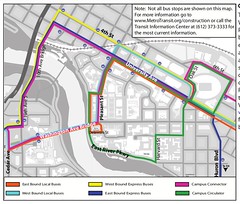The Northern Lights Express project has been granted $5 million in federal funding to be put into preliminary engineering for the 150-mile route between Minneapolis and Duluth. This will only fund an initial phase of engineering work, but it comes at an opportune time—according to presentation information from last July, the draft environmental impact statement (DEIS) phase should have wrapped up now, and they should be moving on to the final EIS for completion around September or October. That's exactly when the NLX Board Chairman said preliminary engineering could begin, according to MPR. He did seem to push back the potential completion date a bit, though. I've previously seen people mentioning 2013 or 2014 as the point when service could begin, but he said 2014 or 2015 in that article.
Cost estimates for the line have wandered all over the map in recent years. Some projections running north of $900 million gave pause, so there were some investigations into alternative configurations along the route. It seems that the leading option these days ("Option 2") would run single-tracked for most of the route, but allow trains to run up to 79 mph between Minneapolis and Coon Rapids, then up to 90 mph north of there as far as Cambridge. Between Cambridge and Hinckley would be 110 mph, double tracked, but speeds would decline to 90 mph again farther north. That design was given a price range of $550 to $750 million—still fairly steep, but probably a lot cheaper than continuing to widen Interstate 35 (though the route much more closely follows Minnesota State Highway 65, MN-107, and MN-23).
There was also news last month that Mn/DOT had again applied for funding to pay for a third main line between the Northtown Yard in Minneapolis and Coon Creek Junction in Coon Rapids, this time under TIGER III. They had originally applied for funds under the original TIGER program, but that got overbooked several times over and the project didn't receive any money. This area is a choke point, since it carries the combined traffic of BNSF's Northern Transcon from Seattle/Portland as well as traffic from Duluth. A third main line should allow about two dozen more trains through per day, which could be split among trains to Duluth as well as additional Northstar service, and potentially more Amtrak service to Fargo. It would get filled up pretty quickly, though—I think the Northern Lights Express is planned to have eight round-trips per day, so it could take up more than 2/3rds of the new slots all by itself.
The third main line project had previously requested $99 million from the feds (out of a total of more than $113 million), which seems like a lot for little more than a mile of new track. However, it would pay for widening the MN-610 bridge over the line to accommodate the new track, plus a new overpass for Foley Boulevard itself. A bigger MN-610 bridge could also allow portions of the proposed Foley Boulevard station to fit underneath. Some money would likely go to BNSF for easement rights as well. I don't know exactly when TIGER-III grants will be announced, but it should happen sometime this coming winter (and the program might get renamed between now and then). The grant request will probably have to be smaller, though—this round is only going to allow matching levels up to 80% rather than the 90% previously allowed.
Anyway, it'd be great if this stuff could line up to begin operation in 2014, just like the Central Corridor.
Speaking of which—Washington Avenue is set to close permanently on the U of MN campus's East Bank between Pleasant and Walnut at midnight early on Monday, May 16th. The existing buses on the street will need to be temporarily rerouted, which had somehow escaped me—My normal bus, the 3, will actually be returning to normal operation at that time, but the Campus Connector and various Metro Transit routes will shift north to University Avenue and 4th Street. Buses will start being rerouted a few days early, on Saturday, May 14th. The buses will eventually return to Washington, but cars will be banned.

Does the cost of NLX include the 3rd mainline project, or does it assume that the 3rd mainline will be done by the time NLX starts construction? It seems like the 3rd mainline is needed in order for NLX to run enough trains.
ReplyDeleteThat's a question that has been in the back of my mind for a while, but I don't have a good answer for that yet. I may try digging through the NLX materials again to find out, or there might be a clue buried in the MN State Rail Plan.
ReplyDeleteSorry I'm too late commenting here, but, do you know what the projected travel time is? In particular, can it be brought down to about 1:50, so that bihourly service requires only two trainsets and hourly service requires only four?
ReplyDeleteI think the initial business plan called for the run to take 2:00 flat, though I'm sure some people wanted it to go a bit faster. The "Option 2" time comes in at 2:17.
ReplyDelete